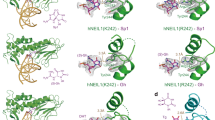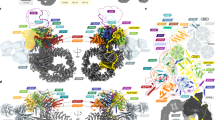Abstract
Histidine triad nucleotide-binding protein (HINT), a dimeric purine nucleotide-binding protein from rabbit heart, is a member of the HIT (histidine triad) superfamily which includes HINT homologues and FHIT (HIT protein encoded at the chromosome 3 fragile site) homologues. Crystal structures of HINT-nucleotide complexes demonstrate that the most conserved residues in the superfamily mediate nucleotide binding and that the HIT motif forms part of the phosphate binding loop. Galactose-1-phosphate uridylyltransferase, whose deficiency causes galactosemia, contains tandem HINT domains with the same fold and mode of nucleotide binding as HINT despite having no overall sequence similarity. Features of FHIT, a diadenosine polyphosphate hydrolase and candidate tumour suppressor, are predicted from HINT-nucleotide structures.
This is a preview of subscription content, access via your institution
Access options
Subscribe to this journal
Receive 12 print issues and online access
$189.00 per year
only $15.75 per issue
Buy this article
- Purchase on Springer Link
- Instant access to full article PDF
Prices may be subject to local taxes which are calculated during checkout
Similar content being viewed by others
References
Seraphin, B. The HIT protein family: a new family of proteins present in prokaryotes yeast and mammals. DNA Sequence 3, 177–179 (1992).
Mozier, N.M., Walsh, M.P. & Pearson, J.D. Characterization of a novel zinc binding site of protein kinase C inhbitor-1. FEBS Lett. 279, 14–18 (1991).
McDonald, J.R. & Walsh, M.P. Ca2+-binding proteins from bovine brain including a potent inhibitor of protein kinase C. Biochem. J. 232, 559–567 (1985).
Brzoska, P.M. et al. The product of the ataxia-telangiectasia group d complementing gene, atdc interacts with a protein kinase c substrate and inhibitor. Proc. Natl. Acad. Sci. USA 92, 7824–7828 (1995).
Lima, C., Klein, M.G., Weinstein, I.B. & Hendrickson, W.A. Three-dimensional structure of human protein kinase C interacting protein 1, a member of the HIT family of proteins. Proc. Natl. Acad. Sci. USA 93, 5357–5362 (1996).
Brzoska, P.M. et al. Cloning, mapping, and in vivo localization of a human member of the PKCI-1 protein family (PRKCNH1). Genomics 36, 151–156 (1996).
Simpson, G.G., Clark, G. & Brown, J.W. Isolation of a maize cDNA encoding a protein with extensive similarity to an inhibitor of protein kinase C and a cyanobacterial open reading frame. Biochim. Biophys. Acta 1222, 306–308 (1994).
Wilson, R. et al. 2.2 Mb of contiguous nucleotide sequence from chromosome III of C. elegans. Nature 368, 32–38 (1994).
Frohlich, K.U. et al. Yeast cell cycle protein CDC48p shows full-length homology to the mammalian protein VCP and is a member of a protein family involved in secretion, peroxisome formation, and gene expression. J. Cell Biol. 114, 443–453 (1991).
Bustos, S.A., Schaefer, M.R. & Golden, S.S. Different and rapid responses of four cyanobacterial psbA transcripts to changes in light intensity. J. Bacteriol. 172, 1998–2004 (1990).
Fleischmann, R.D. et al. Whole–genome random sequencing and assembly of Haemophilus influenzae Rd. Science 269, 496–512 (1995).
Fani, R. et al. Cloning of histidine genes of Azospirillum brasilense: organization of the ABFH gene cluster and nucleotide sequence of the hisB gene. Mol. Gen. Genet. 216, 224–229 (1989).
Bult, C.J. et al. Complete genome sequence of the methanogenic archaeon, Methanococcus jannaschii. Science 273, 1058–1073 (1996).
Fraser, C.M. et al. The minimal gene complement of Mycoplasma genitalium. Science 270, 397–403 (1995).
Ohta, M. et al. The FHIT gene, spanning the chromosome 3p14.2 fragile site and renal carcinoma-associated t(3;8) breakpoint, is abnormal in digestive tract cancers. Cell 84, 587–597 (1996).
Huang, Y., Garrison, P.N. & Barnes, L.D. Cloning of the Schizosaccharomyces pombe gene encoding diadenosine 5′,5-P1,P4-tetraphosphate (Ap4A) asymmetrical hydrolase: sequence similarity with the histidine triad (HIT) protein family. Biochem. J. 312, 925–932 (1995).
Barnes, L.D. et al. FHIT, a putative tumor suppressor in humans, is a dinucleoside 5′,5‴-P-1,P-3-triphosphate hydrolase. Biochemistry 35, 11529–11535 (1996).
McLennan, A.G. Ap4A and Other Dinucleoside Polyphosphatases. (CRC Press, Boca Raton, Florida, 1992).
Sozzi, G. et al The FHIT gene at 3p14.2 is abnormal in lung cancer. Cell 85, 17–26 (1996).
Sozzi, G. et al. Aberrant FHIT transcripts in Merkel cell carcinoma. Cancer Research 56, 2472–2474 (1996).
Negrini, M. et al. The FHIT gene at 3p14.2 is abnormal in breast carcinomas. Cancer Research 56, 3173–3179 (1996).
Virgilio, L. et al. FHIT gene alterations in head and neck squamous cell carcinomas. Proc. Natl. Acad. Sci. USA 93, 9770–9775 (1996).
Shridhar, R. et al. Frequent breakpoints in the 3p14.2 fragile site, Fra3b, in pancreatic tumors. Cancer Research 56, 4347–4350 (1996).
Panagopoulos, I. et al. The FHIT and PTPRG genes are deleted in benign proliferative breast disease associated with familial breast cancer and cytogenetic rearrangements of chromosome band 3p14. Cancer Research 56, 4871–4875 (1996).
Mao, L., Fan, Y.H., Lotan, R. & Hong, W.K. Frequent abnormalities of fhit, a candidate tumor suppressor gene, in head and neck cancer cell lines. Cancer Research 56, 5128–5131 (1996).
Man, S., Ellis, I.O., Sibbering, M., Blarney, R.W. & Brook, J.D. High levels of allele loss at the FHIT and ATM genes in non–comedo ductal carcinoma in situ and grade I tubular invasive breast cancers. Cancer Research 56, 5484–5489 (1996).
Yanagisawa, K. et al. Molecular analysis of the FHIT gene at 3p14.2 in lung cancer cell lines. Cancer Research 56, 5579–5582 (1996).
Geurts, J.M.W., Schoenmakers, E.F.P.M., Roijer, E., Stenman, G. & Van de Ven, W.J.M. Expression of reciprocal hybrid transcripts of HMGIC and FHIT in a pleomorphic adenoma of the parotid gland. Cancer Research 57, 13–17 (1997).
Wedekind, J.E., Frey, P.A. & Rayment, I. Three-dimensional structure of galactose-1-phosphate uridylyltransferase from Escherichia coli at 1.8 Å resolution. Biochemistry 34, 11049–11061 (1995).
Levy, H.L. & Hammersen, G. Newborn screening for galactosemia and other galactose metabolic defects. J. Pediatr. 92, 871–877 (1978).
Branden, C. & Tooze, J. Introduction to Protein Structure (Garland Publishing, New York, 1991).
Rosen, M.K., Michnick, S.W., Karplus, M. & Schreiber, S.L. Proton and nitrogen sequential assignments and secondary structure determination of the human FK506 and rapamycin binding protein. Biochemistry 30, 4774–4789 (1991).
Michnick, S.W., Rosen, M.K., Wandless, T.J., Karplus, M. & Schreiber, S.L. Solution structure of FKBP, a rotamase enzyme and receptor for FK506 and rapamycin. Science 252, 836–839 (1991).
Moore, J.M., Peattie, D.A., Fitzgibbon, M.J. & Thomson, J.A. Solution structure of the major binding protein for the immunosuppressant FK506. Nature 351, 248–250 (1991).
Wilson, K.P. et al. Comparitive X-ray Structures of the Major Binding Protein for the Immunosuppressant FK506 (Tacrolimus) in Unliganded Form and in Complex with FK506 and Rapamycin. Acta Crystallogr. D 51, 511–521 (1995).
Clardy, J. The chemistry of signal transduction. Proc. Natl. Acad. Sci. USA 92, 56–61 (1995).
Guranowski, A. & Sillero, A. Enzymes cleaving dinucleoside polyphosphates. in Ap4A and Other Dinucleoside Polyphosphates (ed. McLennan, A.G.) 81–133 (CRC Press, Boca Raton, FL, 1992).
Booth, J.W. & Guidotti, G. An alleged yeast polyphosphate kinase is actually diadenosine-5′, 5‴-P1,P4-tetraphosphate alpha, beta-phosphorylase. J. Biol. Chem. 270, 19377–19382 (1995).
Wedekind, J.E., Frey, P.A. & Rayment, I. The structure of nucleotidylated Histidine-166 of Galactose-1-Phosphate Uridylyltransferase provides insight into phosphoryl group transfer. Biochemistry 35, 11560–11569 (1996).
Robinson, A.K., de la Pena, C.E. & Barnes, L.D. Isolation and characterization of diadenosine tetraphosphate (Ap4A) hydrolase from Schizosaccharomyces pombe. Biochemica et Biophysica Acta 1161, 139–148 (1993).
Kitzler, J.W., Farr, S.B. & Ames, B.N. Intracellular functions of ApnN: prokaryotes. in Ap4A and Other Dinucleoside Polyphosphates (ed. McLennan, A.G.) (CRC Press, Boca Raton, FL, 1992).
Vartanian, A., Narovlyansky, A., Amchenkova, A., Turpaev, K. & Kisselev, L. Interferons induce accumulation of diadenosine triphosphate (Ap3A) in human cultured cells. FEBS Lett. 381, 32–34 (1996).
Segal, E. & Le Pecq, J.B. Relationship between cellular diadenosine 5′,5‴-P1,P4-tetraphosphate level, cell density, cell growth stimulation and toxic stresses. Exp. Cell Res. 167, 119–126 (1986).
Kabsch, W. Automatic processing of rotation diffraction data from crystals of initially unknown symmetry and cell constants. J. Appl. Crystallogr. 26, 795–800 (1993).
Sheldrick, G.M. SHELXS86, a Program for the Solution of Crystal Structures, (Univ. of Gottingen, Gottingen, FRG, 1985).
Ten Eyck, L.F. & Arnone, A. Three-dimensional Fourier Synthesis of Human Deoxyhemoglobin at 2.5 Angstrom Resolution. J. Mol. Biol. 100, 3–11 (1976).
Wang, B.C. Resolution of phase ambiguity in macromolecular crystallography. Methods Enzymol. 115, 90–112 (1985).
Jones, T.A., Zou, J.Y., Cowan, S.W. & Kjeldgaard, M. Improved methods for building protein models in electron density maps and the location of errors in these models. Acta Crystallogr. A 47, 110–119 (1991).
Kabsch, W., Mannherz, H.G., Suck, D., Pai, E.F. & Holmes, K.C. Atomic structure of the actin:DNAse I complex. Nature 347, 37–44 (1990).
Brunger, A.T. X-PLOR Version 3.1 Manual (Yale University, New Haven, Connecticut, 1993).
Navaza, J. AMoRe: an automated package for molecular replacement. Acta Crystallogr. D 50, 157–163 (1994).
Brunger, G.J. The free R value: a more objective statistic for crystallography. Methods in Enzymol. 277, in press (1997).
Barton, G.J. ALSCRIPT, a tool to format multiple sequence alignments. Protein Engineering 6, 37–40 (1993).
Kraulis, P.J. MolScript: a program to produce both detailed and schematic plots of protein structures. J. Appl. Crystallogr. 24, 946–950 (1991).
Author information
Authors and Affiliations
Rights and permissions
About this article
Cite this article
Brenner, C., Garrison, P., Gilmour, J. et al. Crystal structures of HINT demonstrate that histidine triad proteins are GalT-related nucleotide-binding proteins. Nat Struct Mol Biol 4, 231–238 (1997). https://doi.org/10.1038/nsb0397-231
Received:
Accepted:
Issue Date:
DOI: https://doi.org/10.1038/nsb0397-231
This article is cited by
-
Overexpression of Zm-HINT1 in Arabidopsis thaliana enhances resistance to Fusarium graminearum
Plant Cell, Tissue and Organ Culture (PCTOC) (2015)
-
Molecular cloning and expression analysis of an HINT1 homologue from maize (Zea mays L.)
Plant Molecular Biology Reporter (2011)
-
Fragile histidine triad protein: structure, function, and its association with tumorogenesis
Journal of Cancer Research and Clinical Oncology (2010)
-
Backbone assignment of HINT1 protein, a mouse histidine triad nucleotide binding protein
Biomolecular NMR Assignments (2009)
-
Selective prediction of interaction sites in protein structures with THEMATICS
BMC Bioinformatics (2007)



